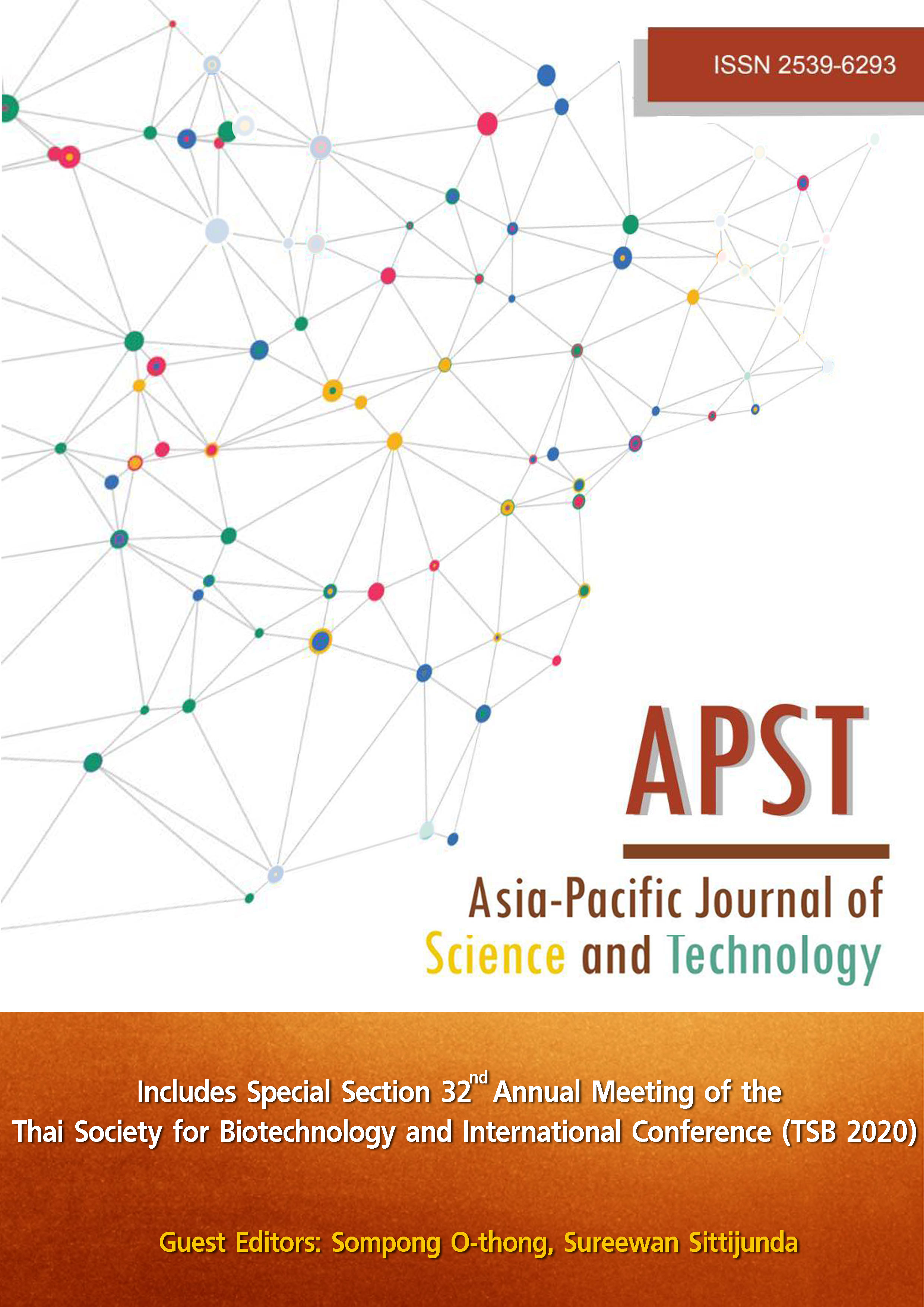Screening of mycoviruses from fungal isolates causing dirty panicle disease in rice seeds
Main Article Content
Abstract
Dirty rice panicle disease, caused by various types of phytopathogenic fungi, results in the damage and deterioration of rice seeds. This disease is mainly controlled by using fungicides. Despite their usefulness, fungicides could pose potential risks to environmental pollution and health. Recently, researchers found that fungi can be infected by various types of mycoviruses that induce hypovirulence. This study aimed to acquire mycoviruses from rice dirty panicle fungi. Pathogenic fungi were isolated from rice fields (Pathum Thani 1 cultivar) in Pathum Thani, Phatthalung, and Chachoengsao province, Thailand. Of the 129 phytopathogenic fungi isolates, most of them were Fusarium spp. (44.17%), followed by Curluvaria spp. (20.93%), Aspergillus spp. (11.62%), and Penicillium spp. (7.75%), and some isolates (15.53%) could not be identified based on their morphology and sporulation. Mycoviruses were screened, and 10 fungal isolates showed viral-double stranded RNA (dsRNA) profiles on agarose gel electrophoresis. The estimated size of the mycovirus varied from 2 to 10 kb, and they were divided into 8 types based on their dsRNA profiles. Moreover, the identification of fungal isolates harbouring mycoviruses based on ITS regions was carried out. The results showed that 10 fungal isolates belonged to the phylum Ascomycota and were distributed in three orders: Pleosporales, Trichosphaeriales, and Hypocreales. This finding suggests the appearance of mycoviruses in various types of fungal isolates. Moreover, the use of mycoviruses as a potential candidate for biocontrol of phytopathogenic fungi should be a subject of further investigation.
Article Details
References
[2] Savary S, Teng P, Willocquet L, Nutter JF. Quantification and modeling of crop losses: a review of purposes. Annu Rev Phytopathol. 2006;44:89-112.
[3] Charoenrak P, Chamswarng C. Efficacies of wettable pellet and fresh culture of Trichoderma asperellum biocontrol products in growth promoting and reducing dirty panicles of rice. Agric Nat Resour. 2016;50(4): 243-249.
[4] Silodia K, Bhale MS, Koutu GK. Prevalence of dirty panicle disease of rice (Oryza sativa L.) in Madhya Pradesh. Int J Chem Stud. 2019;7(4):762-772.
[5] Kanteh S, Kaiwa F, Alami-Bangura A, Kamara W. Pest management decision guide: green and yellow list. https://www.plantwise.org; 2012. [Accessed 20 April 2021].
[6] Jiang D, Fu Y, Guoqing L, Ghabrial SA. Viruses of the plant pathogenic fungus Sclerotinia sclerotiorum. In: Ghabrial SA, editor. Advances in virus research. Academic Press; 2013. p. 215-248.
[7] Kondo H, Kanematsu S, Suzuki N. Viruses of the white root rot fungus, Rosellinia necatrix. In: Ghabrial SA, editor. Advances in virus research. Academic Press; 2013. p. 177-214.
[8] Zhang DX, Nuss DL. Engineering super mycovirus donor strains of chestnut blight fungus by systematic disruption of multilocus vic genes. PNAS. 2016;113(8):2062-2067.
[9] Okada R, Kiyota E, Moriyama H, Fukuhara T, Natsuaki T. A simple and rapid method to purify viral dsRNA from plant and fungal tissue. J Gen Plant Pathol. 2015;81(2):103-107.
[10] Okada R, Ichinose S, Takeshita K, Urayama S, Fukuhara T, Komatsu K, et al. Molecular characterization of a novel mycovirus in Alternaria alternata manifesting two-sided effects: down-regulation of host growth and up-regulation of host plant pathogenicity. Virology. 2018;519:23-32.
[11] Webster J, Weber R. Introduction to Fungi. 3rd ed. Cambridge: Cambridge University Press; 2007.
[12] Altschul SF, Madden TL, Schäffer AA, Zhang J, Zhang Z, Miller W, et al. Gapped BLAST and PSI-BLAST: a new generation of protein database search programs. Nucleic Acids Res. 1997;25(17):3389-3402.
[13] Kumar S, Stecher G, Li M, Knyaz C, Tamura K. MEGA X: molecular evolutionary genetics analysis across computing platforms. Mol Biol Evol. 2018;35(6):1547-1549.
[14] Saechow S, Thammasittirong A, Kittakoop P, Prachya S, Thammasittirong SN-R. Antagonistic activity against dirty panicle rice fungal pathogens and plant growth-promoting activity of Bacillus amyloliquefaciens BAS23. J Microbiol Biotechnol. 2018;28(9):1527-1535.
[15] Shiratori N, Kobayashi N, Tulayakul P, Sugiura Y, Takino M, Endo O, et al. Occurrence of Penicillium brocae and Penicillium citreonigrum, which produce a mutagenic metabolite and a mycotoxin citreoviridin, respectively, in selected commercially available rice grains in Thailand. Toxins. 2017;9(6): 194.
[16] Alasiri H, Bahkali A, Abd-Elsalam K, El-Zeaagi K, Elgorban A, Al-Sum B. Detection of Aspergillus and Penicillium species producing aflatoxin in rice grains imported into Saudi Arabia. Wulfenia. 2013;20:313-323.
[17] Dossou B, Silue D. Rice pathogens intercepted on seeds originating from 11 African countries and from the USA. Seed Sci Technol. 2017;46:31-40.
[18] Urayama S, Kato S, Suzuki Y, Aoki N, Le MT, Arie T, et al. Mycoviruses related to chrysovirus affect vegetative growth in the rice blast fungus Magnaporthe oryzae. J Gen Virol. 2010;91(12):3085-3094.
[19] Cole TE, Mcller BM, Hong Y, Brasier CM, Buck KW. Complexity of virus-like double-stranded RNA elements in a diseased isolate of the Dutch Elm Disease fungus, ophiostoma novo-ulmi. J Phytopathol. 2008;146(11-12):593-598.
[20] Deng F, Xu R, Boland GJ. Hypovirulence-associated double-stranded RNA from Sclerotinia homoeocarpa is conspecific with Ophiostoma novo-ulmi mitovirus 3a-Ld. Phytopathology. 2003;93(11):1407-1414.
[21] Li H, Bian R, Liu Q, Yang L, Pang T, Salaipeth L, et al. Identification of a novel hypovirulence-inducing hypovirus from Alternaria alternata. Front Microbiol. 2019;10:1076.
[22] Salaipeth L, Chiba S, Eusebio-Cope A, Kanematsu S, Suzuki N. Biological properties and expression strategy of Rosellinia necatrix megabirnavirus 1 analysed in an experimental host, Cryphonectria parasitica. J Gen Virol. 2014;95(3):740-750.
[23] Yu J, Park JY, Heo J-I, Kim K-H. The ORF2 protein of Fusarium graminearum virus 1 suppresses the transcription of FgDICER2 and FgAGO1 to limit host antiviral defences. Mol Plant Pathol. 2019;21(2): 230-243.


